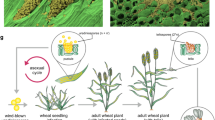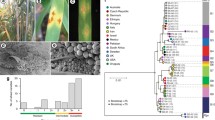Abstract
Major changes have occurred in the global wheat-rust disease landscape over the last century. At the turn of the twentieth century pioneering rust research was driven by the need to combat devastating stem rust epidemics. A fundamental understanding of rust genetics and dispersal pathways emerged from this early work. Stem rust epidemics were also the driver behind the breeding programs that resulted in the green revolution of the 1960/70s. Successful incorporation of durable stem rust resistance into high yielding semi-dwarf wheat cultivars would change the wheat-rust disease situation beyond recognition. Associated intensification of the wheat cropping systems would also produce dramatic changes. Despite localized outbreaks, by the early 1990s stem rust was a disease under control. During this period of low stem rust incidence, yellow rust began to emerge as a substantial threat. Breakdown of Yr9 resistance resulted in damaging epidemics in Asia; an exotic incursion introduced yellow rust into Australia with highly significant subsequent impacts. The Australian incursion was almost certainly transmitted via an air traveller and the exponential growth in international air travel has increased the probability of other cross-continental movements. By the start of the twenty-first century, new rust threats had emerged. Durable stem rust resistance was broken down by the Ug99 race lineage identified in East Africa; new aggressive strains of yellow rust adapted to warmer temperatures were identified and spread across continents at a rapid rate. As in the past, major rust developments are one driver of global initiatives to mitigate the threat. Climate change and the response of pathogens to changing conditions are possible emerging issues, although other changes may prove to be more significant. Throughout this century of change a consistent theme is the adaptability of wheat-rust pathogens to cause recurring damage. Maintaining the gains of the previous decades will require sustained, collaborative, multi-disciplinary efforts. To keep pace with the evolving threats posed by wheat rusts there is a clear need for continuous vigilance and surveillance of both pathogen and host. Current international monitoring and surveillance efforts are described along with associated challenges.






Similar content being viewed by others
References
Agarwal PK (2007) Climate change: implications for Indian agriculture. Jalvigyan Sameeksa 22:37–46
Agarwal PK, Naresh Kumar S, Pathak H (2009) Climate change and wheat production in India: impacts and adaptation strategies. Division of Environmental Sciences, Indian Agriculture Research Institute, New Delhi
BGRI (2010) Proceedings oral papers and posters. In: McIntosh RA (ed) 2009 BGRI technical workshop, Cd. Obregon, Mexico, 17–20 March 2009. Available at: http://www.globalrust.org/db/attachments/resources/737/10/BGRI_2009_proceedings_cimmyt_isbn.pdf. Accessed 26 Oct 2010
Carleton MA (1905) Lessons from the grain-rust epidemic of 1904. USDA Farmers’Bulletin 219. Available at: http://ddr.nal.usda.gov/bitstream/10113/33148/1/CAT87201645.pdf. Accessed 26 Oct 2010
CIMMYT (2005) Sounding the alarm on global stem rust. CIMMYT, Mexico, DF. Available at: http://www.globalrust.org/uploads/documents/SoundingAlarmGlobalRust.pdf. Accessed 1 April 2010
DEFRA (2005) Climate change impacts on agriculture in India. Available at: http://www.defra.gov.uk/environment/climatechange/internat/devcountry/pdf/india-climate-6-agriculture.pdf. Accessed 1 April 2010
Dixon J, Nalley L, Kosina P, Rovere RL, Hellin J, Aquino P (2006) Adoption and economic impact of improved wheat varieties in the developing world. J Agric Sci 144:489–502
Dubin HJ, Brennan JP (2009) Combating stem and leaf rust of wheat. Historical perspective, impacts and lessons learned. In: Spielman D, Pandya-Lorch R (eds) Millions fed: proven successes in agricultural development, IFPRI, Washington D.C., USA. Available at: http://www.ifpri.org/sites/default/files/publications/oc64ch02.pdf. Accessed 1 April 2010
European Centre for Medium-Range Weather Forecasts (2008) ERA-Interim Project. Dataset ds627.0 published by the CISL data support section at the National Center for Atmospheric Research, Boulder, CO. Available at: http://dss.ucar.edu/datasets/ds627.0/. Accessed 1 April 2010
FAOSTAT (2010) FAO Statistical databases. Available at: http://faostat.fao.org/. Accessed 1 April 2010
Flor HH (1956) The complementary gene systems in flax and flax rust. Adv Genet 8:29–54
Goswami BN, Venugopal V, Sengupta D, Madhusoodanan MS, Xavier PK (2006) Increasing trend of extreme rain events over India in a warming environment. Science 314:1442–1445
Hijmans RJ, Cameron SE, Parra JL, Jones PG, Jarvis A (2005) Very high resolution interpolated climate surfaces for global land areas. Int J Climatol 25:1965–1978
Hodson DP, White JW (2007) Use of spatial analyses for global characterization of wheat-based production systems. J Agric Sci 145:115–125
Hodson DP, White JW (2009) Climate change: what future for wheat? In: Dixon J, Braun H-J, Kosina P, Crouch J (eds) Wheat facts and futures. CIMMYT, Mexico D.F. Available at: http://www.cimmyt.org/english/docs/facts/whtfacts09.pdf. Accessed 1 April 2010
Hodson DP, Singh RP, Dixon JM (2005) An initial assessment of the potential impact of stem rust (race Ug99) on wheat producing regions of Africa and Asia using GIS. In: Abstract 7th international wheat conference, Mar del Plata, Argentina, p 142
Hodson DP, Cressman K, Nazari K, Park RF, Yahyaoui A (2009) The global cereal rust monitoring system. In: McIntosh R (ed) ProcTechnical Meeting, BGRI. Ciudad Obregon, Mexico, pp 35–46
Hovmøller MS, Yahyaoui A, Milus EA, Justesen AF (2008) Rapid global spread of two aggressive strains of a wheat rust fungus. Mol Ecol 17:3818–3826
IPCC (2000) Summary for policymakers, emissions scenarios. A special report of IPCC working Group III, Intergovernmental panel on climate change, ISBN: 92-9169-113-5
IPCC (2007) IPCC fourth assessment report—climate change 2007. Available at: http://www.ipcc.ch/. Accessed 1 April 2010
Jenamani RK (2007) Alarming rise in fog and pollution causing a fall in maximum temperature over Delhi. Curr Sci 93:314–322
Jin Y, Pretorius ZA, Singh RP, Fetch T Jr (2008) Detection of virulence to resistance gene Sr24 within race TTKS of Puccinia graminis f. sp. tritici. Plant Dis 92:923–926
Jin Y, Szabo LJ, Rouse MN, Fetch T Jr, Pretorius ZA, Wanyera R, Njau P (2009) Detection of virulence to resistance gene Sr36 within the TTKS race lineage of Puccinia graminis f. sp. tritici. Plant Dis 93:367–370
Joshi LM, Singh DV, Srivastava KD (1986) Wheat and wheat diseases in India. In: Joshi LM, Singh DV, Srivastava KD (eds) Problems and progress of wheat pathology in South Asia. Malhotra Publishing House, New Delhi
Kolmer JA, Jin Y, Long DL (2007) Wheat leaf and stem rust in the United States. Aust J Agric Res 58:631–638
Legreve A, Duveiller E (2010) Preventing potential disease and pest epidemics under a changing climate. In: Reynolds MP (ed) Climate change and crop production. CABI Climate Change Series, pp 50–70
Leonard KJ (2001a) Black stem rust biology and threat to wheat growers. Presentation to Central Plant Board Meeting, Lexington, USA, 5–8 Feb 2001. Available at: http://www.ars.usda.gov/Main/docs.htm?docid=10755. Accessed 1 April 2010
Leonard KJ (2001b) Stem rust—future enemy? In: Peterson PD (ed) Stem rust of wheat: from ancient enemy to modern foe. APS Press, MN, pp 119–146
Lobell DB, Burke MB, Tebaldi C, Mastrandrea MD, Falcon WP, Naylor RL (2008) Prioritizing climate change adaptation needs for food security in 2030. Science 319:607–610
McDonald DB, McIntosh RA, Wellings CR, Singh RP, Nelson JC (2004) Cytogenetical studies in wheat XIX. Location and linkage studies on gene Yr27 for resistance to stripe (yellow) rust. Euphytica 136:239–248
Milus EA, Seyran E, McNew R (2006) Aggressiveness of Puccinia striiformis f. sp. tritici isolates in the South-Central United States. Plant Dis 90:847–852
Milus EA, Kristensen K, Hovmøller MS (2009) Evidence for increased aggressiveness in a recent widespread strain of Puccinia striiformis f. sp. tritici causing stripe rust of wheat. Phytopathology 99:89–94
Nagarajan S, Joshi LM (1978) Epidemiology of brown and yellow rusts of wheat over northern India. II. Associated meteorological conditions. Plant Dis Reptr 62:186–188
Nazari K, Yahyaoui A, Abdalla O, Nachit M, Ogbonnaya F, Brettell R, Rajaram S (2009) Wheat rust diseases in Central and West Asia and North Africa (CWANA) and breeding for the multiple disease resistance. Available at: http://www.abriigenomics.ir/Workshop%20Presentations/Wheat%20rust%20diseases%20in%20CWANA%20ABRII%20MAY%2010-12%20K_Nazari%20et%20al.pdf. Accessed 1 April 2010
Olson EL, Brown-Guedira G, Marshall DS, Jin Y, Mergoum M, Lowe I, Dubcovsky J (2010) Genotyping of US wheat germplasm for presence of stem rust resistance genes Sr24, Sr36 and Sr1RSAmigo. Crop Sci 50:668–675
Park RF (2007) Stem rust of wheat in Australia. Aust J Agric Res 58:558–566
Park RF, Guest DI (2008) Climate change and plant diseases—identifying potential negative impacts and strategies for mitigation. Proceedings of faculty of agriculture, food and natural resources annual symposium (FAFNR ‘08), The University of Sydney, 13 June 2008
Pathak H, Wassman R (2009) Quantitative evaluation of climatic variability and risks for wheat yield in India. Clim Change 93:157–175
Pretorius ZA, Singh RP, Wagoire WW, Payne TS (2000) Detection of virulence to wheat stem rust resistance gene Sr31 in Puccinia graminis f. sp. tritici in Uganda. Plant Dis 84:203
Pretorius ZA, Bender CM, Visser B, Terefe T (2010) First report of a Puccinia graminis f. sp. tritici race virulent to the Sr24 and Sr31 wheat stem rust resistance genes in South Africa. Plant Dis 94:784
Roelfs AP, Singh RP, Saari EE (1992) Rust diseases of wheat: concepts and methods of disease management. CIMMYT, Mexico
Rouse M, Jin Y (2009) Aggressiveness of races TTKSK and QFCSC of Puccinia graminis f. sp. tritici at various temperatures. In: Akkaya MS (ed) Abstract 12th international cereal rusts powdery mildew conference. Available at: http://www.crpmb.org/icrpmc12/ICRPMC_updated-corrected%20abstract%20book_2.pdf. Accessed 1 April 2010
Saari EE, Prescott JM (1985) World distribution in relation to economic losses. In: Roelfs AP, Bushnell WR (eds) The cereal rusts Vol. II: diseases, distribution, epidemiology, and control. Academic Press, Orlando, pp 259–298
Scherm H, Coakley SM (2003) Plant pathogens in a changing world. Australas Plant Pathol 32:157–165
Sharma RC, Duveiller E, Ortiz-Ferrara G (2007) Progress and challenge towards reducing wheat spot blotch threat in the Eastern Gangetic plains of South Asia: is climate change already taking its toll? Field Crops Res 103:109–118
Sidhu PK, Singh H (2009) Assessment of impacts of climate change on rice and wheat in Punjab. Interim Report, Department of Agricultural Meteorology, Ludhiana
Singh RP, William HM, Huerta-Espino J, Rosewarne G (2004) Wheat rust in Asia: meeting the challenges with old and new technologies. In: New directions for a diverse planet: Proc 4th Int Crop Sci Cong, Brisbane, Australia. Available at: http://www.cropscience.org.au./icsc2004/symposia/3/7/141_singhrp.htm. Accessed 1 April 2010
Singh RP, Hodson DP, Jin Y, Huerta-Espino J, Kinyua M, Wanyera R, Njau P, Ward RW (2006) Current status, likely migration and strategies to mitigate the threat to wheat production from race Ug99 (TTKS) of stem rust pathogen. CAB Rev 1:54
Singh RP, Hodson DP, Huerta-Espino J, Jin Y, Njau P, Wanyera R, Herrera-Foessel SA, Ward RW (2008) Will stem rust destroy the world’s wheat crop? Adv Agron 98:271–309
Stakman EC (1957) Problems in preventing plant disease epidemics. Am J Bot 44:259–267
Stakman EC, Harrar JG (1957) Principles of plant pathology. Ronald Press, New York
Stakman EC, Piemeisel FJ (1917) Biologic forms of Puccinia graminis on cereals and grasses. J Agric Res 10:429–495
Wellings CR (2007) Puccinia striiformis in Australia: a review of the incursion, evolution, and adaptation of stripe rust in the period 1979–2006. Aust J Agric Res 58:567–575
Author information
Authors and Affiliations
Corresponding author
Rights and permissions
About this article
Cite this article
Hodson, D.P. Shifting boundaries: challenges for rust monitoring. Euphytica 179, 93–104 (2011). https://doi.org/10.1007/s10681-010-0335-4
Received:
Accepted:
Published:
Issue Date:
DOI: https://doi.org/10.1007/s10681-010-0335-4




